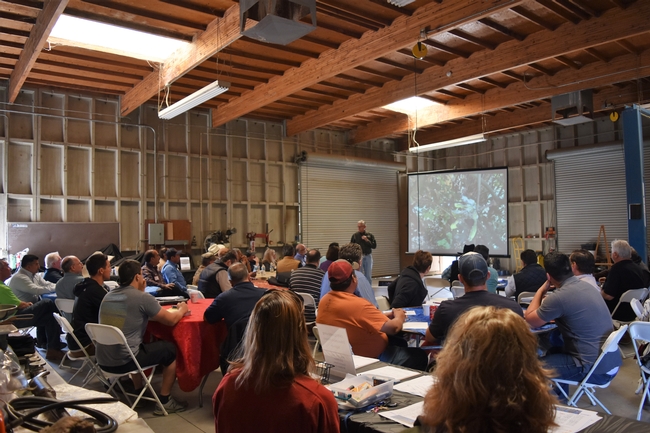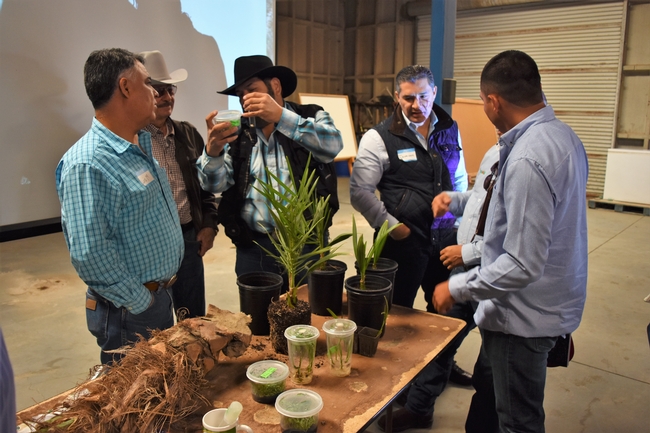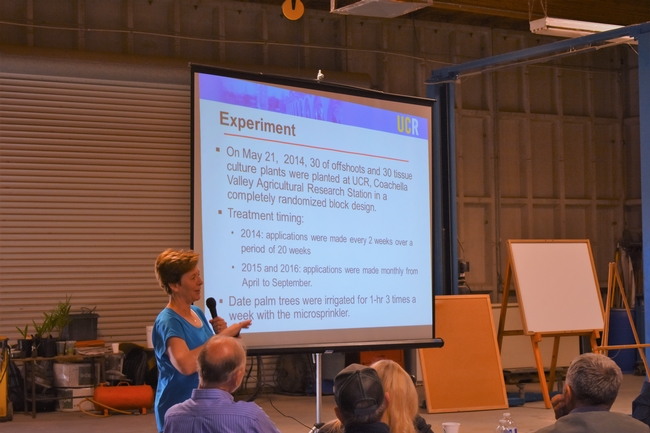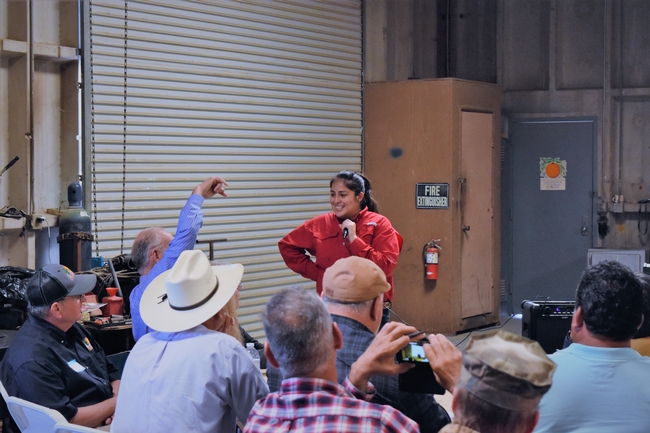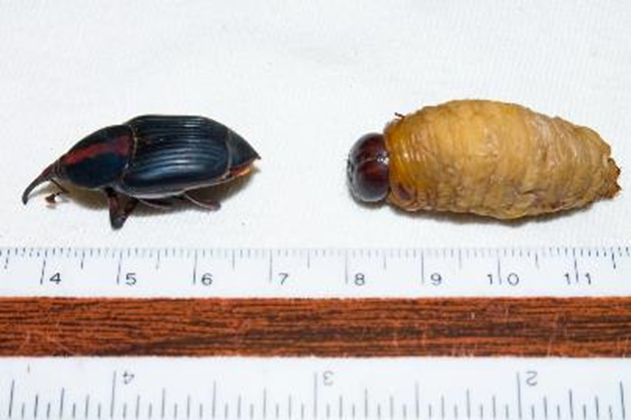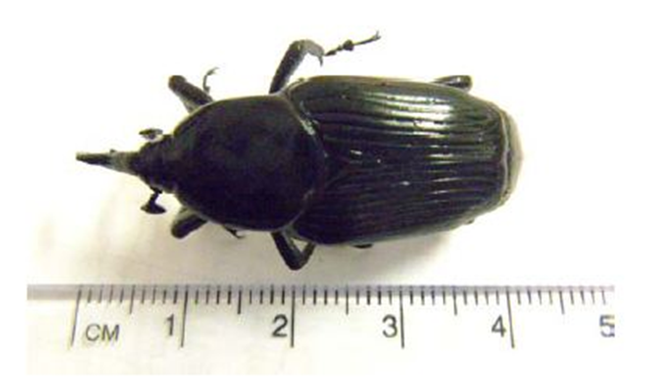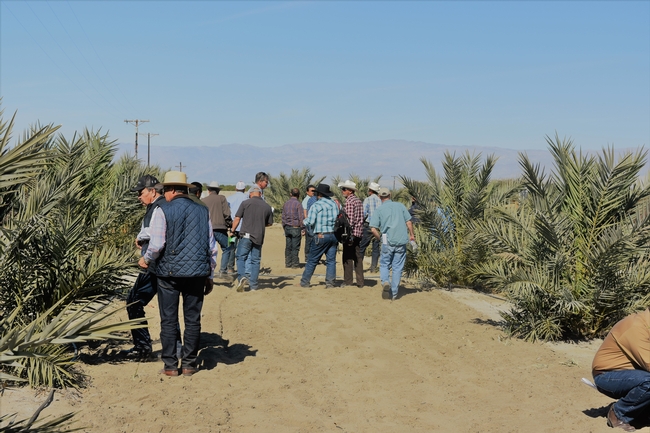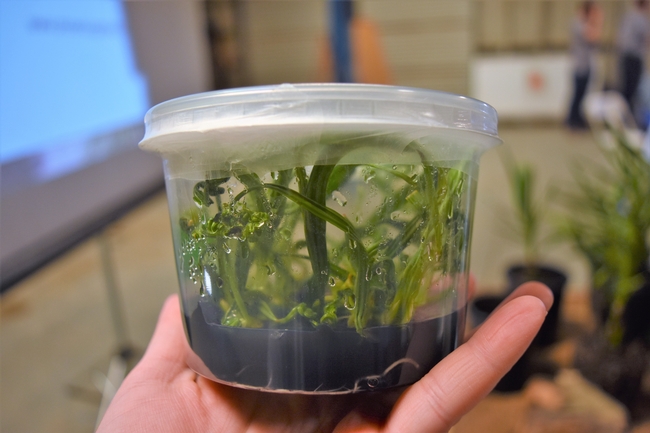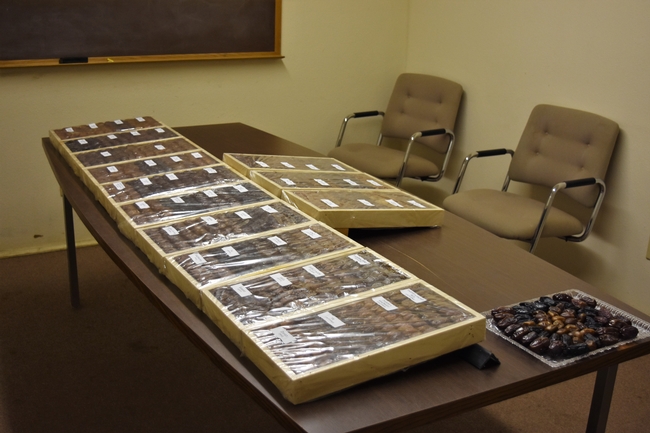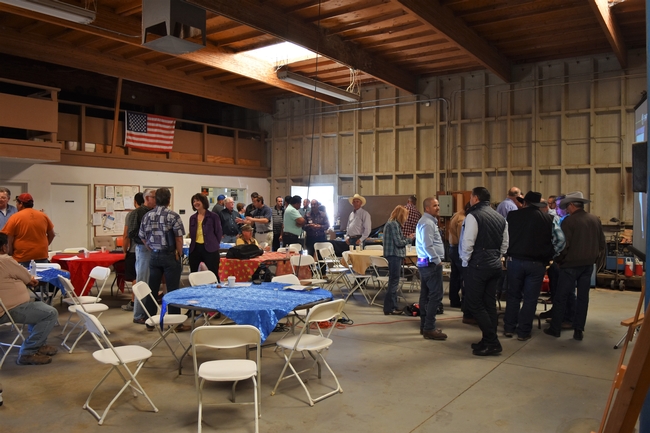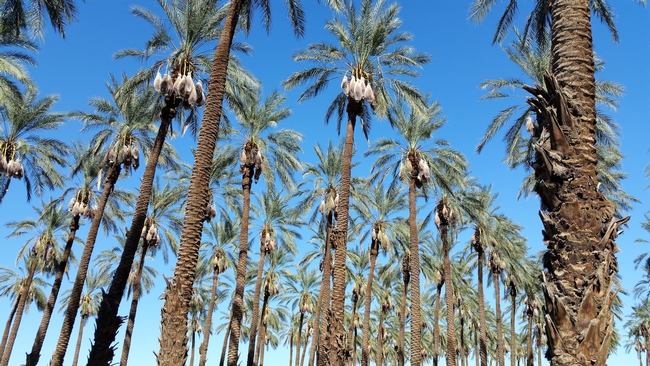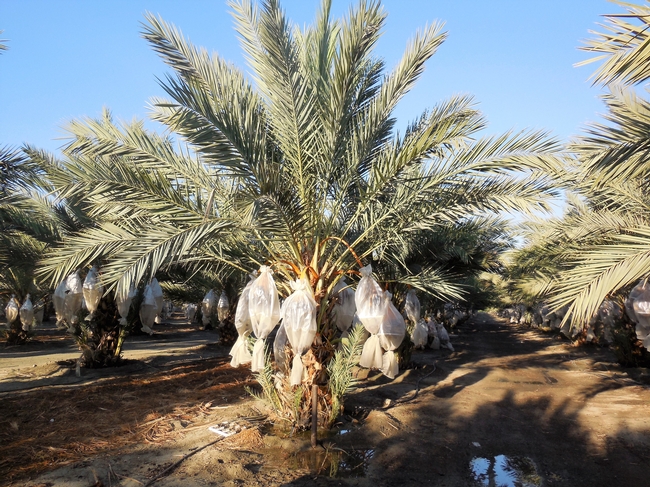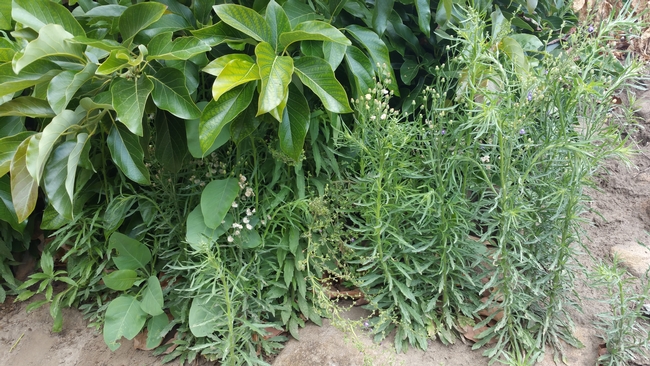
Posts Tagged: dates
2017 Date Field Day: A Success!
The University of California Cooperative Extension (UCCE), UC Riverside, United States Department of Agriculture/Agriculture Research Service (USDA/ARS), and the California Date Commission hosted a Date Field Day on February 15, 2017 at the UC Riverside Coachella Valley Agricultural Research Station. It was a full house that day, with approximately 55 Growers, farm managers, and other date stakeholders. The field day included a field research plot tour, lunch, and Continuing Education hours where available for attendees.
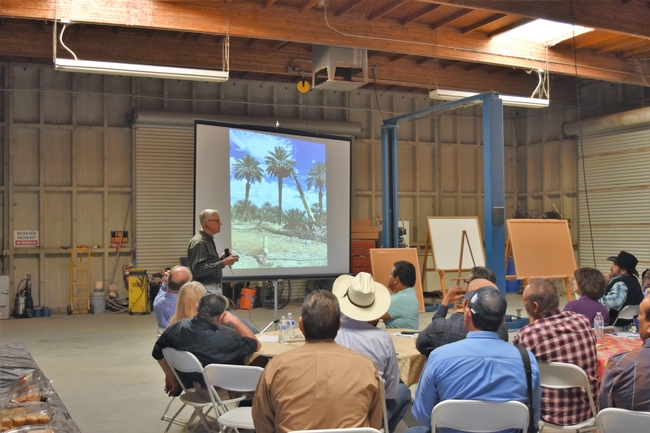
Robert Krueger, Citrus and date researcher Riverside USDA/ARS spoke about nitrogen assessment of date palms. He discussed diagnostic sampling implications, which suggest that there are differences in concentrations of various elements that occur in different portions of the leaf, and at different aged leaves can show different results, and also different seasons may also effect results. Based on the research it is suggested that the best sampling strategy is near khalal stage from middle pinnae of intermediate aged leaves during the summer.
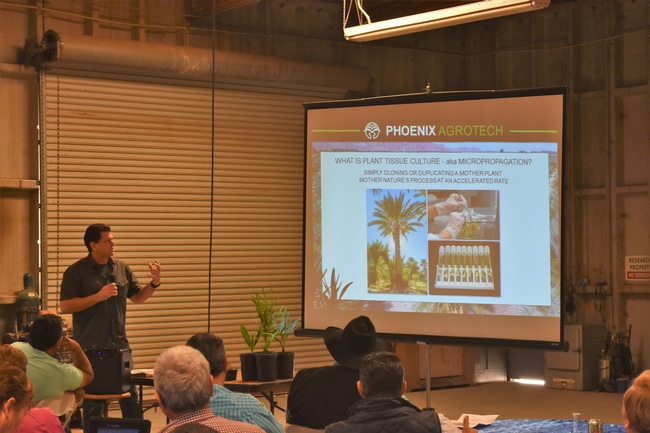
Peggy Mauk, UCCE-UCR Subtropical Horticulture Specialist spoke about establishment of date palms: Tissue Culture vs Off-shoots.
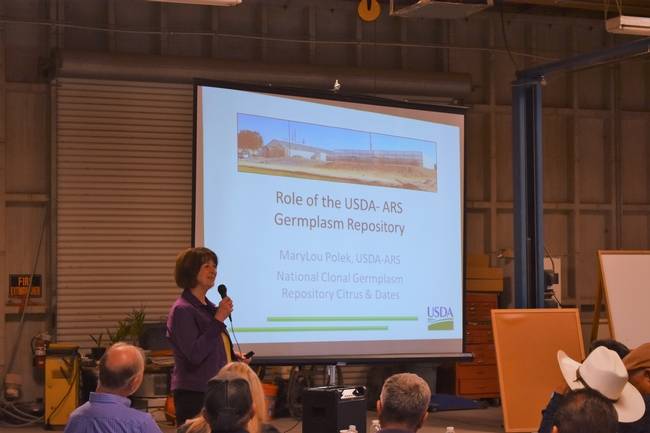
Sonia Rios, UCCE Riverside/San Diego Counties Subtropical Horticulture Farm Advisor spoke about pest issues in date palm, more specifically about weevils . Date palms flourish in high summer temperatures and low humidity which creates a perfect breeding ground and living conditions for pest, especially for the Red palm weevil (Rhynchophorus ferrugineus) (RPW) and South American palm weevil (Rhynchophorus palmarum) (SAPW). The RPW is considered most destructive arthropod pest of palms world-wide. SAPW causes similar damage on smaller scale. Both larvae's can cause economic damage as they feed on palm near apical growing point causing damage, which weakness the tree, and eventually causes death. The SAPW has been eradicated, however the RPW has been slowly showing up in date species in California, threatening the date industry. (Weevil Photos: Mark Hoddle)
The California date industry is worth ~$68 million (NASS, 2015). In 2015, 43,600 tons of dates where harvested. Coachella Valley produces about 95% of the dates consumed in the US. Date palms flourish in high summer temperatures and low humidity climates, which permits their production to certain growing regions. There are many threats to this economically important commodity and the University of California Cooperative Extension and other agencies are committed to assure the date industry thrives locally and globally. The planning committee looks forward to next year's event.
Date Palm Field Day
Date Palms were planted in the Coachella Valley of California, which is approximately two hours east of Los Angeles in the early 1890s. And now, plantings cover over 6,500 plus acres. These acres produce over 40 million pounds of our four primary varieties, which are the Deglet-Noor, the Medjool, the Barhi and the Zahidi.Date palms need plenty of ground water to drink, but high heat and arid weather to produce fruit. Therefore, date palms grow best in hot and arid climates.
Come learn about our date industry in California at the 2017 Date Palm Field Day
Time: 8:00 A.M – 3:00 P.M
Location: Coachella Valley Agricultural Research Station 86501 72nd Ave, Thermal, CA 92274
$15.00/person
Registration link coming soon
(Online registration available on site day of for walk-ins – payment by Card only)
Agenda
8:00 Registration
8:20 Welcome – Sonia Rios, CE Advisor
8:30 Tom Perring, UCR - Pink Hibiscus Mealybug biocontrol
9:00 Robert Krueger, USDA/ARS - Nitrogen assessment of date palms
9:30 Tony Fortier, Phoenix Agrotech - Tissue Culture date palms
10:00 Break
10:15 Peggy Mauk, UCR/CE - Establishment of date palms-Tissue Culture vs Off-shoots
10:45 MaryLou Polek, USDA/ARS - Role of the USDA Germplasm Repository
11:15 TBD
11:45 Lunch
(Included in registration)
1:30 Field tours
If you have any questions contact: Sonia Rios, UC Farm advisor
sirios@ucanr.edu
951.683.6491 Ext. 224
Weed Control in Subtropical Tree Crops
Control of weeds has always been a major economic cost in subtropical fruit production because of favorable climate that allows for weed germination and year-round growth. The use of chemical weed control has increased dramatically due to labor costs, equipment costs, product costs and availability, the shift to more narrowly spaced tree rows, and installation of low volume irrigation systems that prohibit the operation of mowing or tillage equipment under the tree canopy area (Futch 2001).
However finding herbicides that are labeled for certain subtropical crops can be a bigger challenge. UC Weed Science has updated the Subtropical Crops herbicides usage chart for California growers (Fig. 1 Attachment below). It also seems that preventive programs are most frequently overlooked as a method of weed control. Preventive programs entail the use of such practices as sanitation, spot spraying, or hand labor to prevent the source of weed infestation (seed and/or vegetative) from widespread dissemination throughout a given area. By removing the undesirable weed species prior to seed development, dissemination by wind or mechanical transport on equipment can be effectively delayed.
Weed control programs will vary from location to location within the state and can even vary within a given site based upon specific conditions such as soil type, variety, method of herbicide application, and the presence of specific weed species.
Before herbicide application, growers should survey the grove and determine the stage of growth and type of weeds for that given location. Many products do not provide control of emerged species, thus requiring the application of more than one product to provide both preemergence and postemergence protection (Futch 2001). Rotation of soil-applied herbicides should also be considered to prevent the buildup of resistant annual and perennial weeds. The resistant species may not be evident initially; however, if the same herbicide and cultural program is maintained, over time their populations may build up until they infest the entire grove and become the dominant weed species (Jordan et al 1992).
Herbicide damage to foliage and fruit has also been noted when herbicides were applied under windy conditions or use of improper equipment allowed the materials to contact areas other than the weeds or soil. Please make sure to follow the label's direction and use caution.
Attached below is a chart listing herbicides registered for avocado, citrus, date, kiwi, fig and pomegranate.
Figure 1. Herbicide Registration on CA Subtropical Crops
New Subtropical Tree Crops Advisor for Riverside and San Diego
Education:
Rios completed an M.S. in Plant Science with an emphasis in Weed Science from California State University, Fresno, a B.S. in Plant Science from California State Polytechnic University, Pomona
Experience:
Prior to accepting her advisor position, Rios served as a staff research associate in UCCE Tulare County where she assisted advisors in all phases of applied agricultural research (field and greenhouse research on cereal crops, cotton and weed management). She was involved in approximately 30 – 40 research projects that included research testing in herbicide resistance, variety evaluations, and pest management including evaluating new herbicides and insecticides. Rios has conducted and reported agronomy research experiments through data collection that is statistically analyzed, translated and disseminated to clientele; maintained research plots; prepared educational materials for research reports and University publications that would benefit California growers, industry clientele; assisted regulatory agencies with science-based information; conducted radio interviews; and she was a regular speaker at the Tulare County Pesticide Safety meetings. In addition to working with UC, she was also her main professors' student research assistant that would help with trials on campus, assist undergraduates with their research projects and spent time in the classroom teaching.
Rios had also worked with the United States Department of Food and Agriculture (CDFA) inspecting airplanes for Japanese beetle as an Agriculture Aide I. She also worked with the United States Department of Food and Agriculture (USDA) Forest Service as a Forestry Technician.
Rios will be working in education and applied research program in tree crops production and marketing in Riverside and San Diego Counties. Primary target crops are citrus, avocados and dates, but also include other subtropical and deciduous fruit and nut crops, such as pomegranates, figs, mangos and walnuts.
She will facilitate interactions and information exchange among campus based academic, Cooperative Extension advisors and community stakeholders. Focus is expected on increasing productivity and efficiency of commercial tree crops operations, thus maximizing the return on invested capital, and at the same time, providing consumers with a high quality, safe and reasonably-priced product. The advisor will address emerging production issues in subtropical fruit crops including: horticulture, entomology, plant pathology, integrated pest management, plant nutrition and variety testing. She will be working closely with the subtropical horticulture industries, local growers and members of the subtropical horticulture and nuts and fruits workgroup to identify research areas of highest priority. Her contact information is as follows:
Cooperative Extension Riverside County 21150 Box Springs Road, Suite 202 Moreno Valley, CA 92557-8718
Phone#: 951-683-6491
Email Address: sirios@ucanr.edu

Sonia


